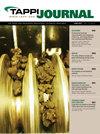Extensive function of green synthesized titania nanoparticles: Photodegradation of Congo red
IF 0.6
4区 农林科学
Q4 MATERIALS SCIENCE, PAPER & WOOD
引用次数: 0
Abstract
Several extensive research studies have explored the advantages of green templates in the synthesis of structure and morphology-controlled photocatalytic nanomaterials. This paper compares the abilities of zingiber rhizome extract (ZE) and tapioca starch extracts (TS) in modifying the surface and optical properties of titania nanoparticles (TNP) synthesized by solgel technique. The synthesized nanocatalysts were characterized using various physicochemical techniques. While zingiber (ginger) extract effectively promotes the formation of dual anatase and rutile phases, tapioca extract supports formation of the single anatase phase of titania. These two extracts were examined for the degradation of Congo red in the presence of sunlight. The photomineralization and recyclability of catalysts were evaluated through total organic content analysis. The easy recovery and reusability of zingiber and tapioca biomasses, along with good control over the growth of nanoparticles, enable them to be implicit novel green templates in the successful synthesis of photoactive mesoporous nanotitania.绿色合成二氧化钛纳米颗粒的广泛功能:光降解刚果红
一些广泛的研究已经探索了绿色模板在合成结构和形态控制的光催化纳米材料中的优势。比较了生姜根提取物(ZE)和木薯淀粉提取物(TS)对溶胶凝胶法合成的纳米二氧化钛(TNP)的表面和光学性能的影响。采用各种物理化学方法对合成的纳米催化剂进行了表征。生姜提取物能有效促进双锐钛矿和金红石相的形成,而木薯提取物则支持二氧化钛单锐钛矿相的形成。研究了这两种提取物在阳光下对刚果红的降解。通过总有机含量分析,评价催化剂的光矿化和可回收性。生姜和木薯生物质易于回收和再利用,以及对纳米颗粒生长的良好控制,使它们成为成功合成光活性介孔纳米二氧化钛的隐含新型绿色模板。
本文章由计算机程序翻译,如有差异,请以英文原文为准。
求助全文
约1分钟内获得全文
求助全文
来源期刊

Tappi Journal
工程技术-材料科学:纸与木材
CiteScore
1.30
自引率
16.70%
发文量
59
审稿时长
6-12 weeks
期刊介绍:
An internationally recognized technical publication for over 60 years, TAPPI Journal (TJ) publishes the latest and most relevant research on the forest products and related industries. A stringent peer-review process and distinguished editorial board of academic and industry experts set TAPPI Journal apart as a reliable source for impactful basic and applied research and technical reviews.
Available at no charge to TAPPI members, each issue of TAPPI Journal features research in pulp, paper, packaging, tissue, nonwovens, converting, bioenergy, nanotechnology or other innovative cellulosic-based products and technologies. Publishing in TAPPI Journal delivers your research to a global audience of colleagues, peers and employers.
 求助内容:
求助内容: 应助结果提醒方式:
应助结果提醒方式:


